The Ram ProMaster is a Fiat design dating to 2014, but it now offers an up-to-date electric powertrain.
In January, Stellantis said its Ram truck brand would start selling the ProMaster EV, a battery-electric model of the ProMaster van that it restyled and updated for 2023. That van, launched in 2014 as the Fiat Ducato, is sold under multiple brands in Europe and elsewhere—but in North America, the company’s truck brand is Ram (no, not Dodge). So we’ve had Ram ProMasters since the 2015 model year, replacing the Dodge Sprinter van based on a design from previous owner Mercedes-Benz. Got all that?
It’s long been known that urban and suburban deliveries are one of the best duty cycles for battery-electric vehicles. This reporter recalls a presentation from the long-vanished British firm Modec, a startup making light delivery vans, which said even back in 2009 that fleet managers would see a lifetime payback on what were then very expensive BEV cargo vans.
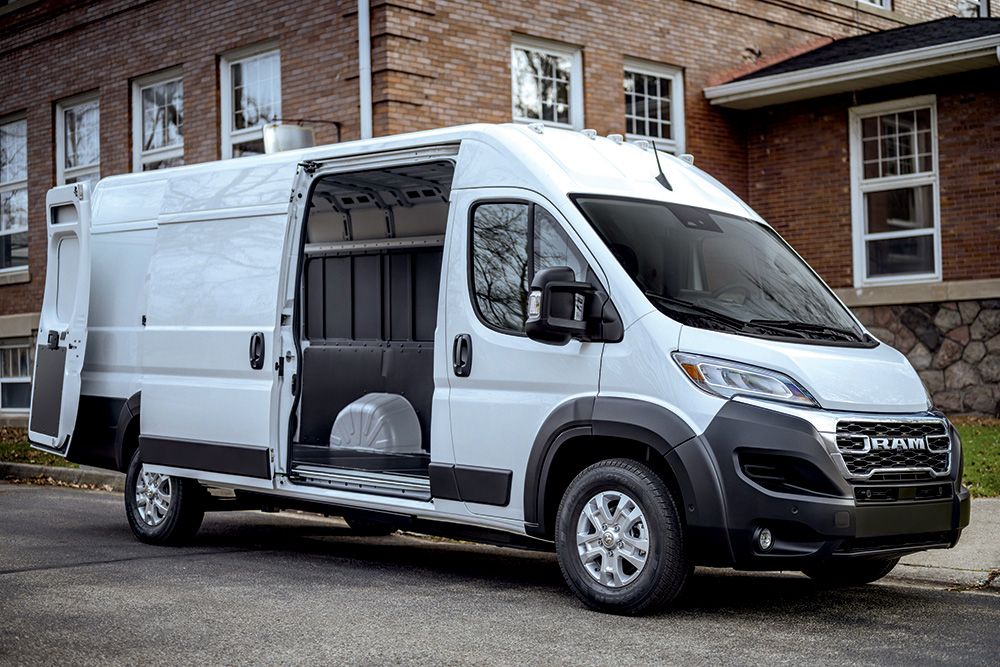

The Ram ProMaster EV’s per-mile operating costs are undoubtedly just a fraction of those for its siblings powered by the company’s 3.6-liter V6 gasoline engine, but the new EV is still quite pricey. It starts just under $90,000, including the mandatory destination fee, while the cheapest gasoline Cargo Van version costs half that. The gas version wins on payload, too, holding 700 to 1,500 pounds more cargo than the EV’s maximum of up to 3,020 pounds.
Taking their time
It’s taken a while to get electric vans into the US market at all. Ford announced its E-Transit only in November 2020, and deliveries started in February 2022. GM started an entirely new brand—BrightDrop—in 2021 to sell not just EV commercial vans but electric cargo containers that work with them, all based on its new Ultium EV platform. Production of those vans was halted in September 2023 as GM struggled to get its higher-volume Ultium-based passenger vehicles into production, but resumed in April.
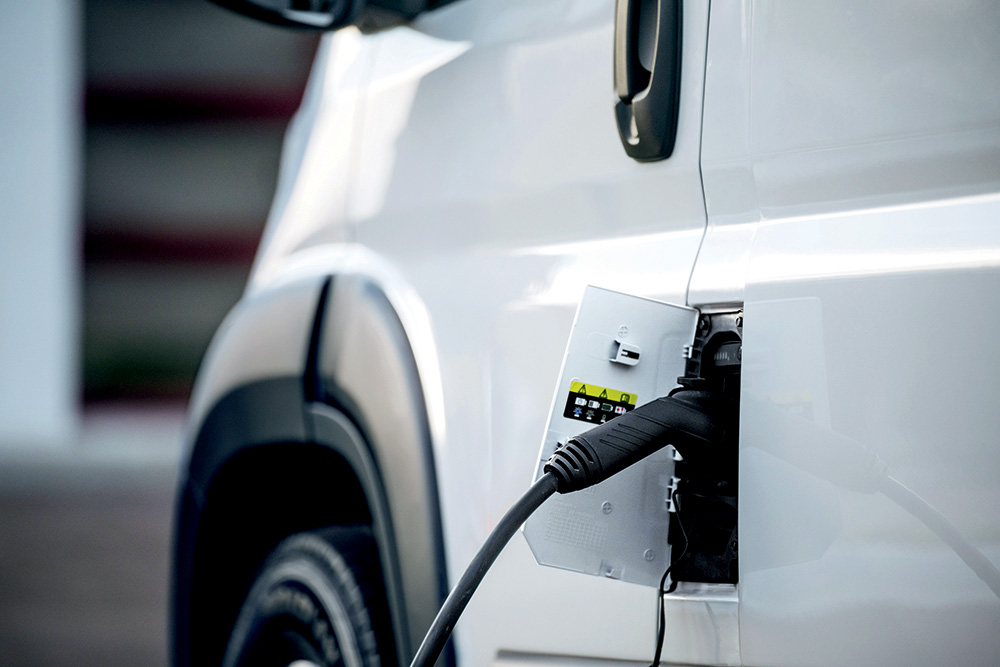

That makes Ram’s announcement significant, because Stellantis is the last of the 2.5 Detroit automakers to offer a battery-electric van for the delivery fleets found throughout the US.
None of the “import” brands currently offer light commercial EVs in the US. Nissan never offered its e-NV200 compact electric van here (and the gasoline NV200 itself is now gone too). After an abortive effort to offer a third-party electric conversion of the first-generation Transit Connect, Ford hasn’t done another compact EV delivery van. (Now it’s even withdrawn that compact van from the US market, shortly after Ram itself killed off its ProMaster City counterpart in 2023.)
Ram is importing its ProMaster EVs from Saltillo, Mexico, while Ford builds E-Transit vans at its Kansas City Assembly plant in Missouri. GM’s BrightDrop vans are assembled in Ingersoll, Canada.
Target: Ford E-Transit
The specs on the ProMaster EV seem designed to go head-to-head with the E-Transit, which Ford just updated for 2024. The ProMaster EV’s 110-kilowatt-hour battery pack is larger than the E-Transit’s newly enlarged 89 kWh, and Ram quotes a “targeted range” of up to 162 miles “in city driving” against the Ford’s estimated 159 miles (for low-roof cargo vans).
The ProMaster EV’s 110 kWh battery pack is larger than the Ford E-Transit’s newly enlarged 89 kWh, and Ram quotes a “targeted range” of up to 162 miles “in city driving” against the Ford’s estimated 159 miles (for low-roof cargo vans).
The Ram’s battery powers a 200 kW (268 hp) motor driving the front wheels, rated at 302 lb-ft of torque. All-wheel drive is not offered. The Ford, while almost identical on power, has a rear-mounted motor that’s rated at 198 kW (266 hp) and produces 317 lb-ft of torque.


Unusually, Ram offers a choice of no less than four DC fast charging speeds: 50 kW, 85 kW, 125 kW and 150 kW. (In comparison, the Ford E-Transit added a second onboard charger for 2024, boosting its peak charging power to 176 kW from the previous 115 kW peak.) We’re not aware of any other maker with the variety of charging speeds offered by Ram. Ram also offers a Level 2 wall charging station capable of delivering up to 11 kW.
Specs for commercial users
The ProMaster EV comes in two versions: the Delivery model, with a “super-high” roof and an aluminum roll-up rear door, and two Cargo models with conventional rear “church doors,” one with a 12-foot cargo length and one with 13 feet. The Delivery model also eliminates the side cargo doors and even the passenger seat, but has a right front “pocket door” for easier access. All three versions ride on the same 159-inch wheelbase. The Delivery model can be ordered now, while the two Cargo versions will be available for order later this year, though Stellantis did not specify when. Ultimately, Ram says, five models will be available, spanning two roof heights, two cargo lengths (12 feet and 13.5 feet), and two body styles.
Ultimately, Ram says, five models will be available, spanning two roof heights, two cargo lengths (12 feet and 13.5 feet), and two body styles.
The Delivery configuration, the first to go on sale, has a higher roof and offers up to 2,030 pounds of payload—perhaps suited to Amazon cartons, though maybe not to an entire load of industrial components or heavier goods. The two Cargo models’ payload is higher, rated at 3,020 pounds.
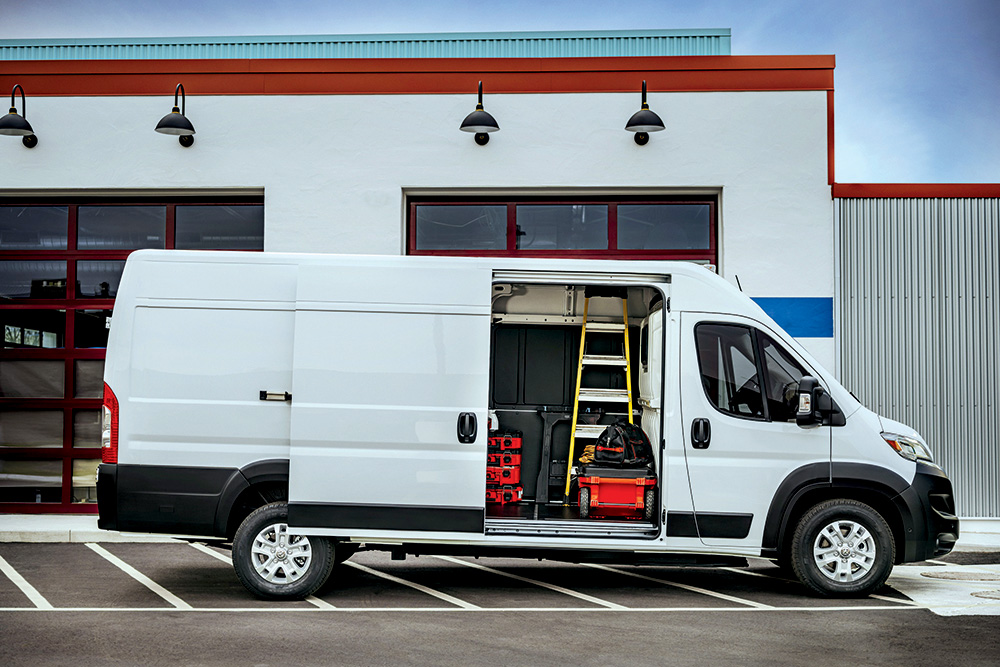

Ram says the ProMaster EV has the most vertical side walls of any available cargo van, and that its cargo height and width are best-in-class 86 inches and 75.6 inches respectively. Total cargo volume is 524 cubic feet, identical to that of the gasoline ProMaster.
Telematics key for fleets
Crosstown competitor Ford has split out its commercial vehicles and data services into the Ford Pro unit, which it expects to be a major profit center for the company as it transitions to EVs over the next 15 years. Ram, too, offers a suite of telematics services to let fleet managers monitor their vehicles, oversee driver behavior, and maximize the efficiency of routing, usage and in the case of EVs, charging.
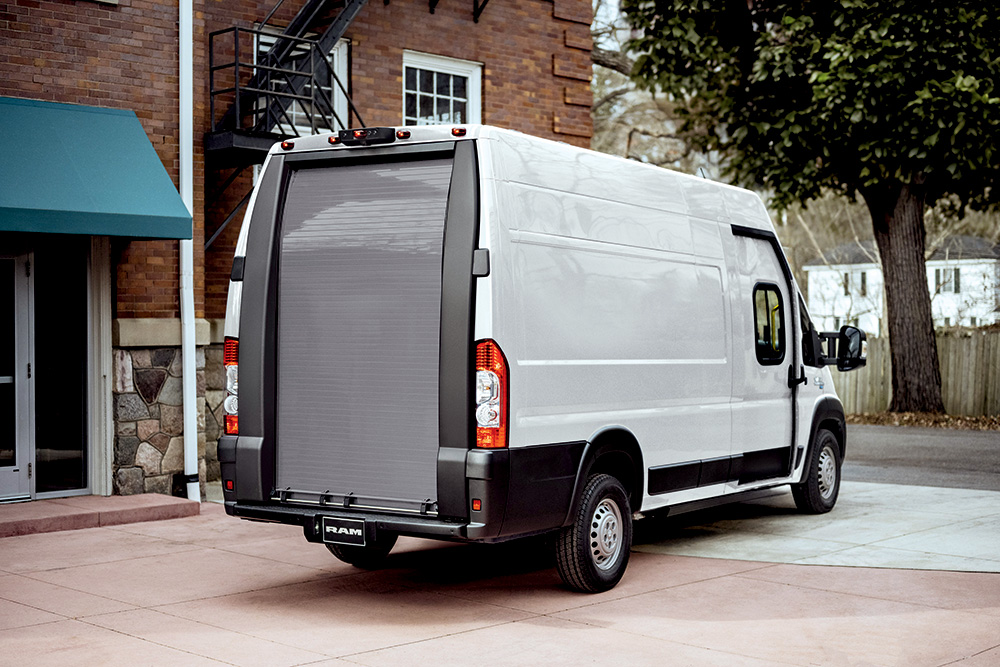

Fleet-friendly features include Ram Telematics, which tracks vehicle locations, provides real-time diagnostics and performance data, and offers driving insights to optimize route efficiency, promote safer driving and cut energy usage. Last-mile navigation features offer drivers instructions to get from the van’s parking spot to their final delivery destination, via the company’s UConnect infotainment interface and its companion smartphone app.
A crucial feature for fleets will be the Charging Station Locator, for drivers whose routes exceed the van’s rated range. EV Dynamic Trip Prediction keeps an eye on remaining range, modeling it against the predicted energy use.
Another crucial feature for fleets will be the Charging Station Locator, for drivers whose routes exceed the van’s rated range. EV Dynamic Trip Prediction keeps an eye on remaining range, modeling it against predicted energy use. Operating information appears inside the vehicle on a reconfigurable 10.1-inch Uconnect touchscreen in the center of the dash. Android Auto and Apple CarPlay are standard.
Automated driver assistance for safety
While delivery vans were once spartan, basic vehicles, they now come equipped with standard and optional features that rival any passenger car on the market. The Ram ProMaster EV comes with forward-collision alert, crosswind assist, post-crash braking, driver-drowsiness detection, traffic-sign information and automatic high beams—all as standard equipment.
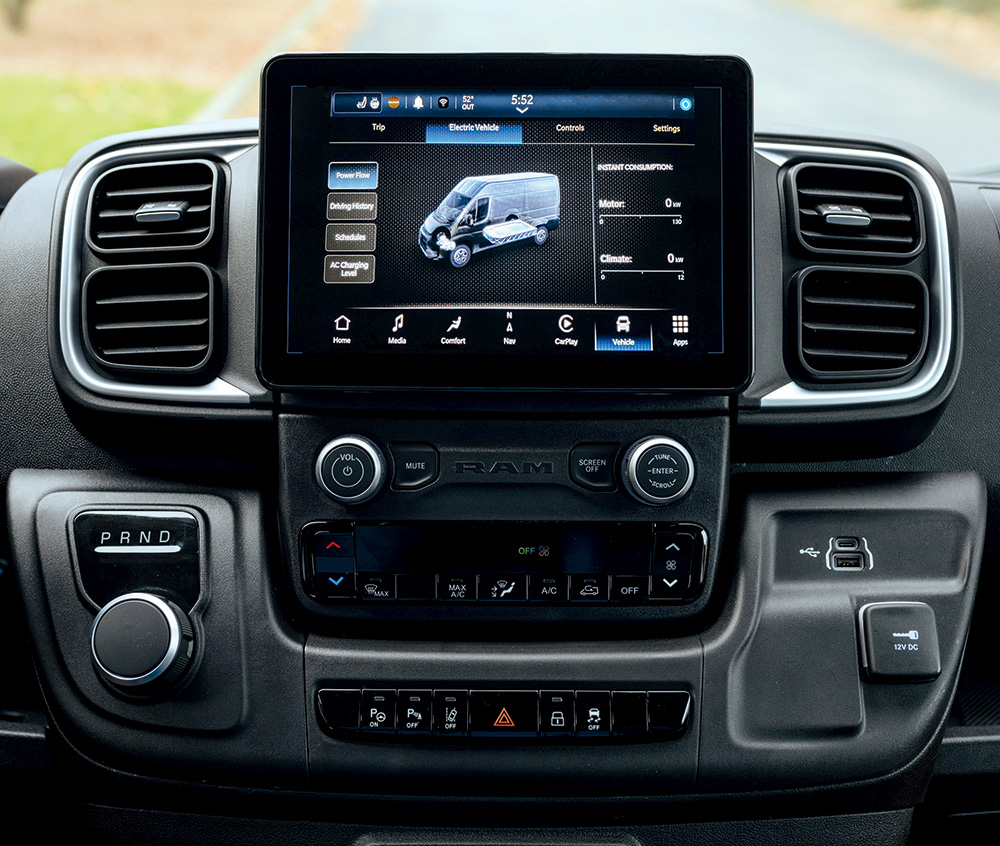

Because the most requested feature for large-van buyers is better visibility around the entire vehicle, the ProMaster EV includes a high-resolution backup camera with dynamic grid lines that show the vehicle’s trajectory as it backs up. A video rear-view mirror that shows an unobstructed view from a rear-facing camera is optional, as is Surround View 360-degree camera display.
Active Driving Assist comprises adaptive cruise control with lane centering, which Stellantis terms an SAE Level 2 automated driving system. It requires not only that the driver keep eyes on the road, but also hands on the wheel—unlike GM’s Super Cruise, Ford’s BlueCruise, or the Mercedes-Benz Drive Pilot, all of which allow hands-off operation as long as the driver watches the road. That said, neither the Ford E-Transit nor GM’s BrightDrop electric vans offer hands-off adaptive cruise control either.
This article first appeared in Issue 67: January-March 2024 – Subscribe now.























